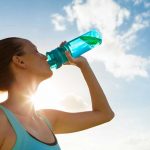
If you are wanting to live a healthy lifestyle, improve your fitness, or if you are on a weight loss journey, there are key elements to consider to ensure you achieve success.
Eating a healthy, varied, and balanced diet is crucial, increasing your physical activity is very beneficial, and we have become aware in recent years of the importance of a good night’s sleep, but one element of the equation we don’t give as much importance to is ensuring we drink enough fluids to stay hydrated.
Dehydration can be the result of inadequate water intake, a lack of minerals in your diet, poor adrenal gland function, or because of chronic stress or trauma, or excess caffeine or alcohol intake.
Symptoms of dehydration include pounding headaches, constipation, dizzy spells, increased hunger, urine that is a darker colour, tiredness, dry mouth, muscle cramps, and lackluster skin tone and complexion.
Here are 4 top tips for you to boost your hydration:
1. To absorb fluids into your cells, your body needs to have adequate supplies of calcium, magnesium, sodium, potassium, and chloride, which is why a balanced and varied diet is so important to hydration.
When fluid stays outside of your cells, it manifests as a feeling of fluid retention, which for some people can be so noticeable, that they can bloat, and their clothing can cut into them as the day progresses. This can be reduced by improving the mineral balance of your diet, and ensuring you take care of your liver.
Green leafy vegetables have a diverse mineral profile, including calcium, magnesium, and potassium, and foods such as legumes, whole grains, yogurts, eggs, meat, fish, fruits, and vegetables can help ensure you are getting all the nutritional elements you need to boost hydration levels from your fluid intake.
Fluid isn’t just about what you drink – fluid-filled foods such as fruit and vegetables can contain up to 90% fluid, such as cucumber, lettuce, celery, and tomatoes. Other vegetables with a good fluid percentage include green peppers, cauliflower, broccoli, green cabbage, spinach, and baby carrots. Fruits with a good level of fluid include melon, berries, grapefruit, oranges, nectarines, and pineapple.
2. The clearer the liquid the better. However, if you find it hard to drink plain water, try adding some slices of fresh fruit for flavour, or add a small amount of sugar-free cordial. Do not rely on caffeinated drinks such as tea, coffee, and fizzy minerals, as these dehydrate the body. You should also drink your fluids cold as often as possible.
3. Aim to drink fluids with every meal and snack, as well as in between food, even if it is just sipped here and there, it all adds up to boosted hydration. Drinking fluids with meals aids digestion and keeping a water bottle to hand makes it easier for you to reach for fluids throughout the day.
4. Track your daily intake of fluids, but especially water. Set a reminder on your phone to drink every half hour, draw markers on the bottle of how much you should drink each time, and keep a note on your phone or in a diary of how many cups or litres you aim to drink each day, and how many you achieve.
Increasing your fluid intake will not solely and miraculously improve your health and fitness or aid your weight loss. However, in combination with a healthy eating plan such as the We Slim Together Community, hydration is a key component in aiding your weight loss journey.
For more information on the WST Community, go to www.weslimcommunity.com
